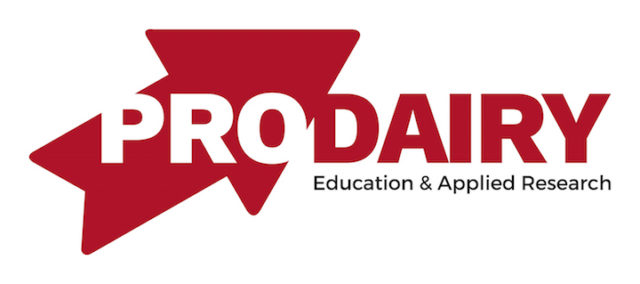Milk processing is a vital value-added link in the dairy production chain from cow to carton. Due to the industry’s high demand for skilled graduates, many universities have recently upgraded their campus creameries to provide the best learning environment about processing milk for their students.
The following facility upgrades include university upgrades since 2013.
University of Wisconsin – Madison
The University of Wisconsin – Madison Babcock Hall Dairy Plant opened in 1951 and since then has supplied bottled milk, ice cream and cheese to the campus population. The 9,000-square-foot plant contains freezers, batching tanks, storage, bottling equipment and cheese rooms.
The plant is currently producing 400-pound batches of cheese during student classes. The UW – Madison Center for Dairy Research recently decided to completely overhaul the entire facility to meet modern education and processing needs.
“We are currently in the final planning stage, and we hope to be fully operational by 2018,” says director John Lucey.
The new 60,000-square-foot plant will include renovations to the old plant along with a second processing and teaching building.
“One of the most exciting parts of the plant will be the nine ripening rooms, complete with temperature and humidity control,” Lucey says. These rooms will be used to produce specialty cheese with surface growths such as blue cheese and Camembert.
“As far as I’m aware, this will be the first university facility of its kind in the U.S.,” Lucey says.
Apart from 150 undergraduate students and 35 masters students, 1,500 industry course participants will use Babcock Hall plant each year.
“Our industry colleagues are also interested in the area of aseptics, like UHT products,” he says. “It’s an exciting prospect to be able to teach and research these products on campus. The Asian and North African export markets often have poor refrigeration, so developing more UHT protein drinks, creamers, etc., will boost our industry, farmers and our university.”
Cornell University
In 2010, Cornell University demolished its campus creamery built in the mid-1900s. The brand-new plant, which opened in 2013, handles 397,000 gallons of milk annually.
“The new plant is fully computerized – from intake to processing to packaging,” says Tim Barnard, Cornell University dairy plant manager. The plant contains two raw milk silos, three mixing tanks, a complete blend system, HTST pasteurizing (high-temperature short-time), five finished product tanks, two rotary fillers and mix-proof valve technology.
The plant is used for research and extension work, with interns working alongside the regular staff.
Yogurt and ice cream are manufactured for sale on campus, with some cheese made in the pilot plant.
The pilot plant contains
cheese-making equipment, micro-filtration, an ultra-pasteurized unit, freeze drier, yogurt separator (used to make Greek yogurt) and whey powdering equipment.
“The plant is industry-spec, which allows us to run 12 industry workshop courses each year,” Barnard says.
University of Connecticut
The University of Connecticut has had sporadic production of fluid milk, cheese and ice cream since its campus plant opened in 1955. In the late 1990s, the plant was fully shut down except for a small section of ice cream production.
 Since 2013, the plant has steadily grown in size and production due to continued refurbishment and building extensions.
Since 2013, the plant has steadily grown in size and production due to continued refurbishment and building extensions.
UConn students manufacture many cheeses, such as short- and long-aged cheddar; however, their specialty cheese is juustoleipa.
 “It’s an old recipe from northern Finland,” says UConn dairy science professor Dennis D’Amico. “The cheese is baked in an oven to give it a crispy coating, which stops it from melting when cooked on a grill.”
“It’s an old recipe from northern Finland,” says UConn dairy science professor Dennis D’Amico. “The cheese is baked in an oven to give it a crispy coating, which stops it from melting when cooked on a grill.”
Recent improvements to the plant include replacing an ice-builder unit with a glycol chiller and second freezer, and a new cheese line complete with an industrial oven.
 In the past, the juustoleipa cheese was cooked individually in a pizza oven, but the new industrial-size capacity oven has lowered labor needs and increased output. The plant upgrades have also allowed more space for dairy research.
In the past, the juustoleipa cheese was cooked individually in a pizza oven, but the new industrial-size capacity oven has lowered labor needs and increased output. The plant upgrades have also allowed more space for dairy research.
“Our undergraduates have done some interesting research with the engineering faculty on heat transfer and dynamics of ‘no sugar added’ products,” D’Amico says.
 D’Amico himself has also researched and developed a new queso blanco cheese (in chili and plain flavor), which won an American Cheese Society Medal.
D’Amico himself has also researched and developed a new queso blanco cheese (in chili and plain flavor), which won an American Cheese Society Medal.
“We’ve already made great progress from producing 16,000 gallons of ice cream in 1999 to 43,000 gallons in 2014, and our expansion will continue in the near future. It’s an exciting time for the University of Connecticut,” D’Amico says.

University of Oregon
Having closed down during the 1960s, the University of Oregon’s campus creamery reopened three years ago and is now producing cheese and ice cream for retail sale.
The project was part-funded by industry and also received an endowment from retired industry member Paul Arbuthnot. “These funds were crucial to building a new modern-standard facility,” says Lisbeth Goddik, dairy processing professor and extension specialist at the University of Oregon.
 The 1,500-square-foot building is equipped with specialized cheese vats for hard and high-moisture cheeses, a temperature/humidity room for aging cheese and an ice cream line. Further upgrades, including a cheese slicer and an auto-filler for ice cream production, are planned for the near future.
The 1,500-square-foot building is equipped with specialized cheese vats for hard and high-moisture cheeses, a temperature/humidity room for aging cheese and an ice cream line. Further upgrades, including a cheese slicer and an auto-filler for ice cream production, are planned for the near future.
An industry-standard dairy lab has also been built that allows students to learn about antibiotic testing, milk and cheese composition and product microbiology.
 Apart from teaching students, the plant is also used for research projects. Goddick and her team are currently researching milk “terroir.” Terroir, a French word meaning land, refers to the unique flavors associated with products from a certain region.
Apart from teaching students, the plant is also used for research projects. Goddick and her team are currently researching milk “terroir.” Terroir, a French word meaning land, refers to the unique flavors associated with products from a certain region.
“Terroir is not just a marketing tool to say that a product from a certain region is unique, like champagne from the Champagne region,” Goddick says. “Our research proves that milk from certain areas of Oregon has scientifically proven unique flavor compounds.” These compounds occur naturally to the specific environment of an area and can influence the taste of the final product of cheese or ice cream.
 Goddick says the most important benefit of the new plant is the increased interest in dairy science from the 230 agricultural students.
Goddick says the most important benefit of the new plant is the increased interest in dairy science from the 230 agricultural students.
“The entire plant is student-run, apart from a managing supervisor,” Goddick says. “Because of the student involvement, we have more involvement from industry employers at our career days, since more students are studying dairy [food] science.”
Washington State University
Russ Salvadalena, Washington State University creamery manager, is currently overseeing a whey processing upgrade of the campus creamery.
“We used to wash whey down the drain, but due to the high biological oxygen demand of whey in our city’s wastewater plant, we switched to hauling it back to the farm lagoon,” Salvadalena says.
A second tanker truck was purchased to haul whey to the lagoon six times a week. The growing importance of whey in the processing industry encouraged WSU to find an alternative to their whey management.
“Nowadays, cheese is the byproduct of whey, as opposed to the other way round,” Salvadalena says. “To meet our students’ need for whey processing education and research opportunities, we are currently designing a two-story, 2,000-square-foot processing building.” The project is in the final design phase, and building work will begin this fall.
The ground floor of the plant will contain a receiving area and cheese processing area. The second floor will have classrooms, a viewing area and changing facilities.
A reverse osmosis membrane, which uses pressure to extract water through the membrane from the whey solids, will remove two-thirds of the whey water content.
Reducing the volume of waste whey will minimize the number of truck loads sent to the farm lagoon. In time, the university hopes to manufacture the whey into value-added products.
“Our industry participants and full-time students have always appreciated our cheese workshops, and this new plant will offer the first steps toward a comprehensive whey workshop program,” Salvadalena says. PD
Michael Cox was a 2015 Progressive Dairyman editorial intern.
PHOTO 1: A new cheese plant at UW-Madison will include nine ripening rooms, complete with temperature and humidity control. Photo provided by John Lucey.
PHOTOS 2-6: Improved equipment and building extensions at the University of Connecticut have allowed the creamery to win national awards including the Green Chile Queso Blanco winning third in its category at the 2015 American Cheese Society Competition. Photos provided by Dennis D’Amico.
PHOTOS 7-9: The team at University of Oregon is currently using improved facilities to research milk “terroir,” the unique flavors specific to milk from Oregon cows. Photos provided by Lisbeth Goddik.






